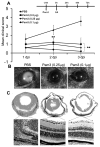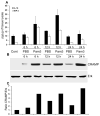Toll-like receptor 2 ligand-induced protection against bacterial endophthalmitis
- PMID: 19995266
- PMCID: PMC2798006
- DOI: 10.1086/649589
Toll-like receptor 2 ligand-induced protection against bacterial endophthalmitis
Abstract
Background: Activation of innate immunity plays a key role in determining the outcome of an infection. Here, we investigated whether Toll-like receptors (TLRs) are involved in retinal innate response and explored the prophylactic use of TLR2 ligand in preventing bacterial endophthalmitis.
Methods: C57BL/6 mice were given intravitreal injections of Pam3Cys, a synthetic ligand of TLR2, or vehicle (phosphate-buffered saline) 24 h prior to Staphylococcus aureus inoculation. The severity of endophthalmitis was graded by slit lamp, electroretinography, histological examinations, and determination of bacterial load in the retina. The expression of cytokines/chemokines and cathelicidin-related antimicrobial peptide was assessed by enzyme-linked immunosorbent assay and Western blot, respectively.
Results: Intravitreal injections of Pam3Cys up-regulated TLR2 expression in the retina of C57BL/6 mice, and Pam3Cys pretreatment significantly improved the outcome of S. aureus endophthalmitis, preserved retinal structural integrity, and maintained visual function as assessed by electroretinography in C57BL/6 mice. Furthermore, Pam3Cys pretreatment activated retinal microglia cells, induced the expression of cathelicidin-related antimicrobial peptide, and remarkably reduced the bacterial load.
Conclusions: This is the first report that highlights the existence and role of TLR2 in retinal innate immune response to S. aureus infection and suggests that modulation of TLR activation provides a novel prophylactic approach to prevent bacterial endophthalmitis.
Conflict of interest statement
Figures






References
-
- Cebulla CM, Flynn HW., Jr Endophthalmitis after open globe injuries. Am J Ophthalmol. 2009;147:567–8. - PubMed
-
- Chiquet C, Cornut P-L, Benito Y, et al. Eubacterial PCR for Bacterial Detection and Identification in 100 Acute Postcataract Surgery Endophthalmitis. Invest Ophthalmol Vis Sci. 2008;49:1971–1978. - PubMed
-
- Krause L, Bechrakis NE, Heimann H, Kildal D, Foerster MH. Incidence and outcome of endophthalmitis over a 13-year period. Can J Ophthalmol. 2009;44:88–94. - PubMed
-
- Diago T, McCannel CA, Bakri SJ, Pulido JS, Edwards AO, Pach JM. Infectious endophthalmitis after intravitreal injection of antiangiogenic agents. Retina. 2009;29:601–5. - PubMed
-
- Scott IU, Flynn HW., Jr Reducing the risk of endophthalmitis following intravitreal injections. Retina. 2007;27:10–2. - PubMed
Publication types
MeSH terms
Substances
Grants and funding
LinkOut - more resources
Full Text Sources
Medical

